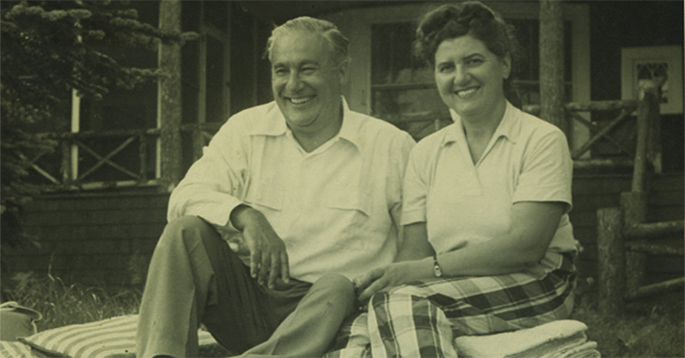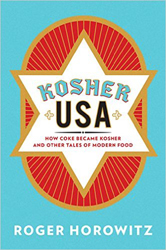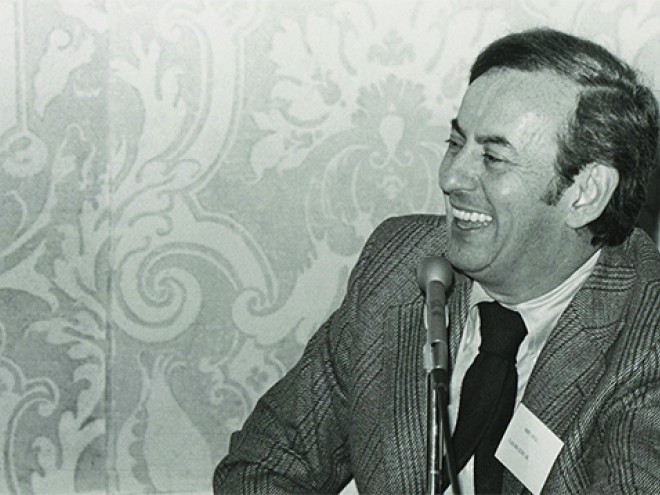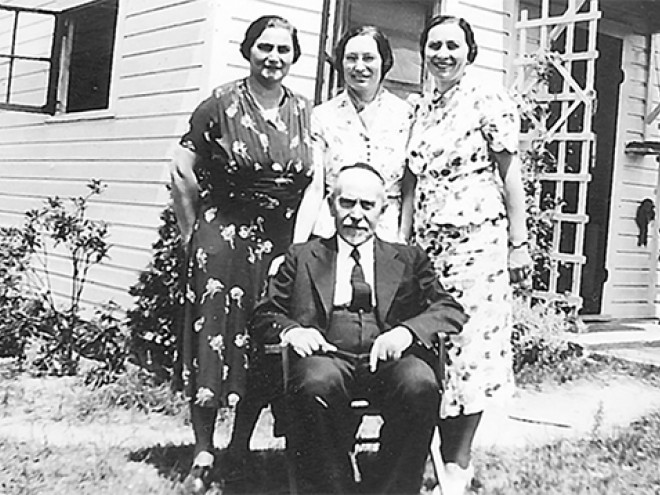Roger Horowitz is the author of Kosher USA: How Coke Became Kosher and Other Tales of Modern Food. Following up Elissa Altman’s writing about Treyf last week, Roger is guest blogging for the Jewish Book Council all week as part of the Visiting Scribe series here on The ProsenPeople.
 Bertie and Charles Schwartz, Lake Placid, New York. Image provided courtesy of Roger Horowitz
Bertie and Charles Schwartz, Lake Placid, New York. Image provided courtesy of Roger Horowitz
When I spoke to the Jewish Book Council in May to promote Kosher USA, I had to preface my pitch by explaining my family connection to the organization. My grandmother Bertie Schwartz was Jewish Book Council’s first women president. She comes into my book mostly through my mother’s stories, told to me over visits to her Upper West Side apartment after spending time in New York City archives, usually while we were eating sandwiches sent in from Fine & Schapiro Deli on 72nd street.
I relate one of those stories in detail in my book: how Bertie obtained kosher meat for the family’s summer residence in Lake Placid, New York in the 1950s. This entailed ordering a kosher beef forequarters (weighing perhaps 200 pounds) from an Albany slaughterhouse, cutting them into pieces small enough to prepare for a dinner, kashering them with salt as required under kosher law, and then freezing the cuts for use during the summer.
Elsewhere, though, Bertie enters in to my book as co-author (with her husband Charles) of Faith Through Reason, a widely distributed primer on Judaism and Jewish law, first published in 1946 and reprinted several times. I return several times to this text to help explain the nature of Judaism to readers, and also to the particular way in which I learned about my religion. What I didn’t go into further is what writing the book reflected, more deeply, about Bertie’s remarkable intellectual and personal commitment to Jewish literacy.
College-educated and with a law degree from New York University, Bertie believed deeply that education and lifelong learning was the key to Jewish advancement in America. During World War II she travelled frequently to a reading center for Jews in the Bronx, an exhausting journey she eventually had to give up — she used that time instead instead to write Faith Through Reason with Charles. Following the war she became involved in many Jewish organizations, most with an emphasis on books and education. She lead courses for synagogue librarians and even created a basic Jewish home library distributed through Jewish organizations. She was a member of the Task Force on Art and Literature in Jewish Life of the Federation of Jewish Philanthropies and an editorial consultant to Judaica Book News. She created the Charles and Bertie G. Schwartz Reading Room and Library at the Steinberg Center of the American Jewish Congress, once located just off 5th Avenue on 85th street. All this while also working as one of the only Jews in the American Mother’s Committee, where she met, among other luminaries, Eleanor Roosevelt. And, of course, she became deeply involved in the Jewish Book Council in the 1960s and 1970s.
I remember her as a veritable force of nature, always with books piled on every surface in her home, and asking her teenage grandson (me) to help with new devices that she hoped would make her more efficient, such as an early home copy machine that we could never get to work properly. She died suddenly, a young 75, of a heart attack, while running to catch a taxi as she was late for a meeting. While saddened, my mother always reflected how the way Bertie died said so much about her determination and energy. My grandmother would be so proud of the Jewish Book Council, not only for what her old organization now does, but for the continuing commitment of it and its many members to books and Jewish education. It was one of my greatest pleasures writing my book that I was able to share with others some of what she sought to give to Judaism.
Roger Horowitz is a food historian and director of the Center for the History of Business, Technology, and Society at the Hagley Museum and Library. He is the author of Negro and White, Unite and Fight, Putting Meat on the American Table, and Kosher USA.
JBC relies upon the support of our readers to continue in our mission to promote the reading, writing, and publication of Jewish literature. Please consider making a donation!
Related Content:
- Anna Solomon: A Grandmother’s Secrets
- Lisa Alcalay Klug: For the Sake of Unification
- Boris Fishman: It’s the First Week of June. Do You Know Where Your Family History Is?
Roger Horowitz is a food historian and director of the Center for the History of Business, Technology, and Society at the Hagley Museum and Library. He is the author of Negro and White, Unite and Fight: A Social History of Industrial Unionism in Meatpacking, 1930 �“ 1990 and Putting Meat on the American Table: Taste, Technology, Transformation.
Roger Horowitz is available to be booked for speaking engagements through Read On. Click here for more information.



